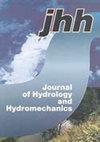Simulation and prediction of water temperature in a water transfer channel during winter periods using a new approach based on the wavelet noise reduction-deep learning method
IF 2.4
4区 环境科学与生态学
Q3 WATER RESOURCES
引用次数: 0
Abstract
In winter, the water transfer channel of the Middle Route of South-to-North Water Transfer Project (MR-StNWTP) in China always encounters ice problems. The preciously simulation and prediction of water temperature is essential for analyzing the ice condition, which is important for the safety control of the water transfer channel in winter. Due to the difference of specific heat between water and air, when the air temperature rises and falls dramatically, the range of change of water temperature is relatively small and has a lag, which often affects the accuracy of simulation and prediction of water temperature based on air temperature. In the present study, a new approach for simulating and predicting water temperature in water transfer channels in winter has been proposed. By coupling the neural network theory to equations describing water temperature, a model has been developed for predicting water temperature. The temperature data of prototype observations in winter are preprocessed through the wavelet decomposition and noise reduction. Then, the wavelet soft threshold denoising method is used to eliminate the fluctuation of certain temperature data of prototype observations, and the corresponding water temperature is calculated afterward. Compared to calculation results using both general neural network and multiple regression approaches, the calculation results using the proposed model agree well with those of prototype measurements and can effectively improve the accuracy of prediction of water temperature.利用基于小波降噪-深度学习法的新方法模拟和预测冬季输水渠道的水温
每到冬季,中国南水北调中线工程(MR-StNWTP)的输水渠道总会遇到结冰问题。对水温的精密模拟和预测是分析结冰情况的关键,对冬季输水渠道的安全控制具有重要意义。由于水与空气的比热不同,当气温急剧升降时,水温的变化范围相对较小,且具有滞后性,这往往会影响基于气温的水温模拟和预测的准确性。本研究提出了一种模拟和预测冬季输水渠道水温的新方法。通过将神经网络理论与水温描述方程相结合,建立了一个预测水温的模型。通过小波分解和降噪对冬季原型观测的温度数据进行预处理。然后,使用小波软阈值去噪方法消除原型观测数据中某些温度数据的波动,之后计算出相应的水温。与使用一般神经网络和多元回归方法计算的结果相比,使用所提出模型的计算结果与原型测量结果吻合度较高,能有效提高水温预测的准确性。
本文章由计算机程序翻译,如有差异,请以英文原文为准。
求助全文
约1分钟内获得全文
求助全文
来源期刊
CiteScore
4.20
自引率
5.30%
发文量
30
审稿时长
>12 weeks
期刊介绍:
JOURNAL OF HYDROLOGY AND HYDROMECHANICS is an international open access journal for the basic disciplines of water sciences. The scope of hydrology is limited to biohydrology, catchment hydrology and vadose zone hydrology, primarily of temperate zone. The hydromechanics covers theoretical, experimental and computational hydraulics and fluid mechanics in various fields, two- and multiphase flows, including non-Newtonian flow, and new frontiers in hydraulics. The journal is published quarterly in English. The types of contribution include: research and review articles, short communications and technical notes. The articles have been thoroughly peer reviewed by international specialists and promoted to researchers working in the same field.

 求助内容:
求助内容: 应助结果提醒方式:
应助结果提醒方式:


